3D Printing in Modern Society: Benefits for Small Manufacturers
VerifiedAdded on 2020/05/04
|9
|1903
|257
Report
AI Summary
This report explores the significant impact of 3D printing on traditional manufacturing techniques, emphasizing its potential to revolutionize industry practices. Through additive manufacturing, companies can significantly reduce material costs and waste by efficiently developing prototypes. The technology also supports small manufacturers in creating their own spare parts, reducing dependency on external suppliers. Economic analyses suggest that while initial investments are high, long-term savings in labor, materials, and inventory management make 3D printing a viable alternative to conventional methods. As the market for 3D printing is projected to grow substantially by 2020, its implications on operations strategy, resource allocation, and production processes become increasingly pertinent. Overall, the adoption of 3D technologies not only fosters innovation but also enhances economic scalability across various sectors.

3D printing
Paraphrase This Document
Need a fresh take? Get an instant paraphrase of this document with our AI Paraphraser
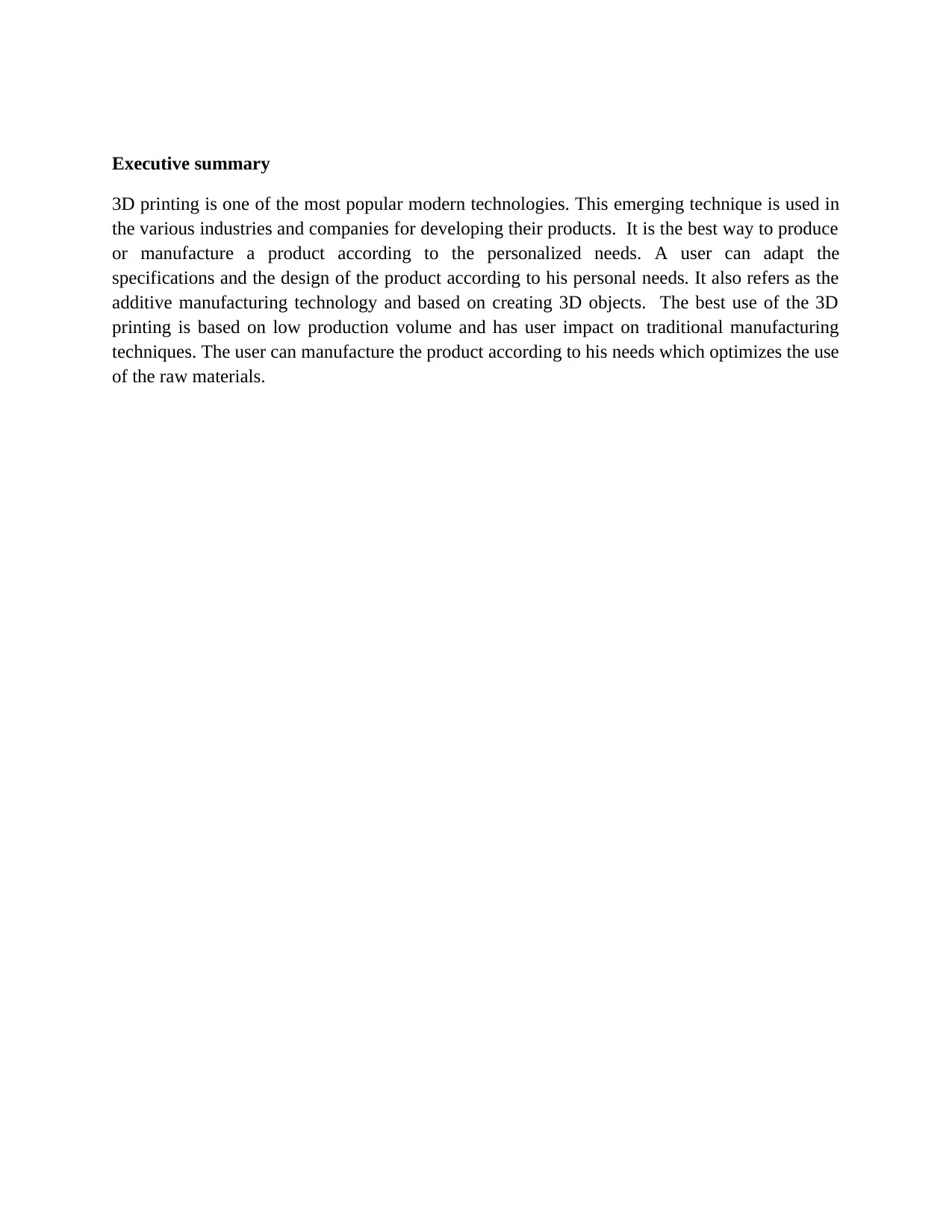
Executive summary
3D printing is one of the most popular modern technologies. This emerging technique is used in
the various industries and companies for developing their products. It is the best way to produce
or manufacture a product according to the personalized needs. A user can adapt the
specifications and the design of the product according to his personal needs. It also refers as the
additive manufacturing technology and based on creating 3D objects. The best use of the 3D
printing is based on low production volume and has user impact on traditional manufacturing
techniques. The user can manufacture the product according to his needs which optimizes the use
of the raw materials.
3D printing is one of the most popular modern technologies. This emerging technique is used in
the various industries and companies for developing their products. It is the best way to produce
or manufacture a product according to the personalized needs. A user can adapt the
specifications and the design of the product according to his personal needs. It also refers as the
additive manufacturing technology and based on creating 3D objects. The best use of the 3D
printing is based on low production volume and has user impact on traditional manufacturing
techniques. The user can manufacture the product according to his needs which optimizes the use
of the raw materials.
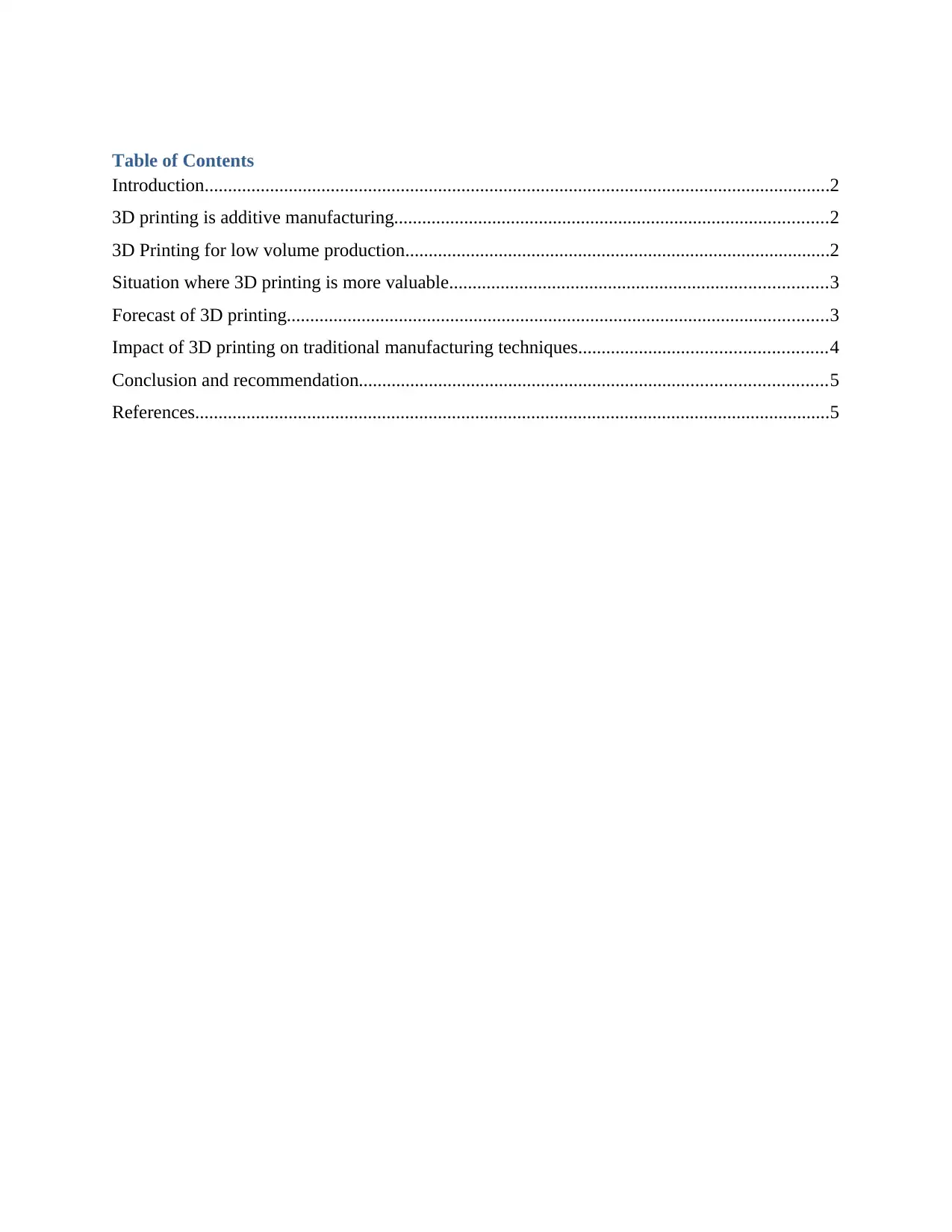
Table of Contents
Introduction......................................................................................................................................2
3D printing is additive manufacturing.............................................................................................2
3D Printing for low volume production...........................................................................................2
Situation where 3D printing is more valuable.................................................................................3
Forecast of 3D printing....................................................................................................................3
Impact of 3D printing on traditional manufacturing techniques.....................................................4
Conclusion and recommendation....................................................................................................5
References........................................................................................................................................5
Introduction......................................................................................................................................2
3D printing is additive manufacturing.............................................................................................2
3D Printing for low volume production...........................................................................................2
Situation where 3D printing is more valuable.................................................................................3
Forecast of 3D printing....................................................................................................................3
Impact of 3D printing on traditional manufacturing techniques.....................................................4
Conclusion and recommendation....................................................................................................5
References........................................................................................................................................5
⊘ This is a preview!⊘
Do you want full access?
Subscribe today to unlock all pages.

Trusted by 1+ million students worldwide
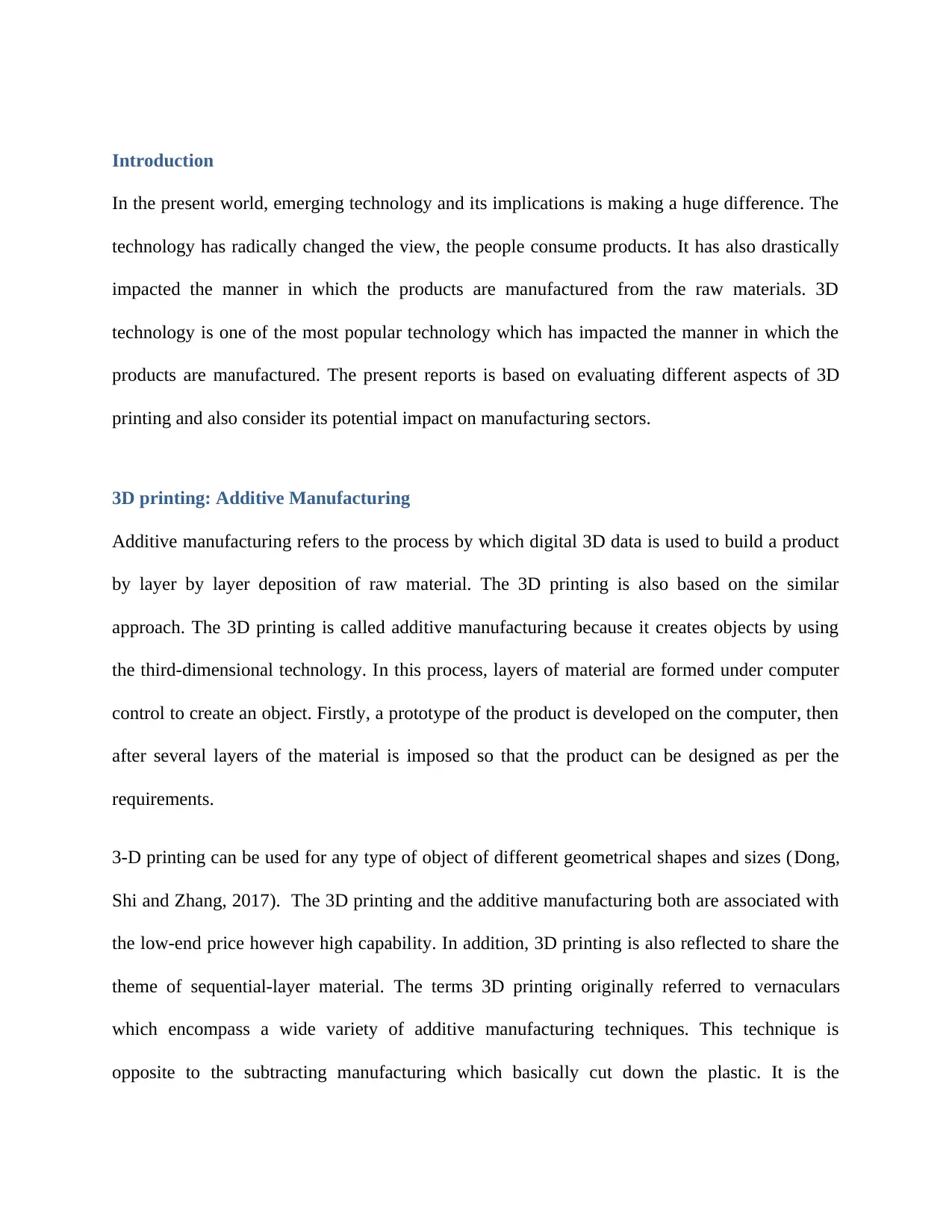
Introduction
In the present world, emerging technology and its implications is making a huge difference. The
technology has radically changed the view, the people consume products. It has also drastically
impacted the manner in which the products are manufactured from the raw materials. 3D
technology is one of the most popular technology which has impacted the manner in which the
products are manufactured. The present reports is based on evaluating different aspects of 3D
printing and also consider its potential impact on manufacturing sectors.
3D printing: Additive Manufacturing
Additive manufacturing refers to the process by which digital 3D data is used to build a product
by layer by layer deposition of raw material. The 3D printing is also based on the similar
approach. The 3D printing is called additive manufacturing because it creates objects by using
the third-dimensional technology. In this process, layers of material are formed under computer
control to create an object. Firstly, a prototype of the product is developed on the computer, then
after several layers of the material is imposed so that the product can be designed as per the
requirements.
3-D printing can be used for any type of object of different geometrical shapes and sizes (Dong,
Shi and Zhang, 2017). The 3D printing and the additive manufacturing both are associated with
the low-end price however high capability. In addition, 3D printing is also reflected to share the
theme of sequential-layer material. The terms 3D printing originally referred to vernaculars
which encompass a wide variety of additive manufacturing techniques. This technique is
opposite to the subtracting manufacturing which basically cut down the plastic. It is the
In the present world, emerging technology and its implications is making a huge difference. The
technology has radically changed the view, the people consume products. It has also drastically
impacted the manner in which the products are manufactured from the raw materials. 3D
technology is one of the most popular technology which has impacted the manner in which the
products are manufactured. The present reports is based on evaluating different aspects of 3D
printing and also consider its potential impact on manufacturing sectors.
3D printing: Additive Manufacturing
Additive manufacturing refers to the process by which digital 3D data is used to build a product
by layer by layer deposition of raw material. The 3D printing is also based on the similar
approach. The 3D printing is called additive manufacturing because it creates objects by using
the third-dimensional technology. In this process, layers of material are formed under computer
control to create an object. Firstly, a prototype of the product is developed on the computer, then
after several layers of the material is imposed so that the product can be designed as per the
requirements.
3-D printing can be used for any type of object of different geometrical shapes and sizes (Dong,
Shi and Zhang, 2017). The 3D printing and the additive manufacturing both are associated with
the low-end price however high capability. In addition, 3D printing is also reflected to share the
theme of sequential-layer material. The terms 3D printing originally referred to vernaculars
which encompass a wide variety of additive manufacturing techniques. This technique is
opposite to the subtracting manufacturing which basically cut down the plastic. It is the
Paraphrase This Document
Need a fresh take? Get an instant paraphrase of this document with our AI Paraphraser
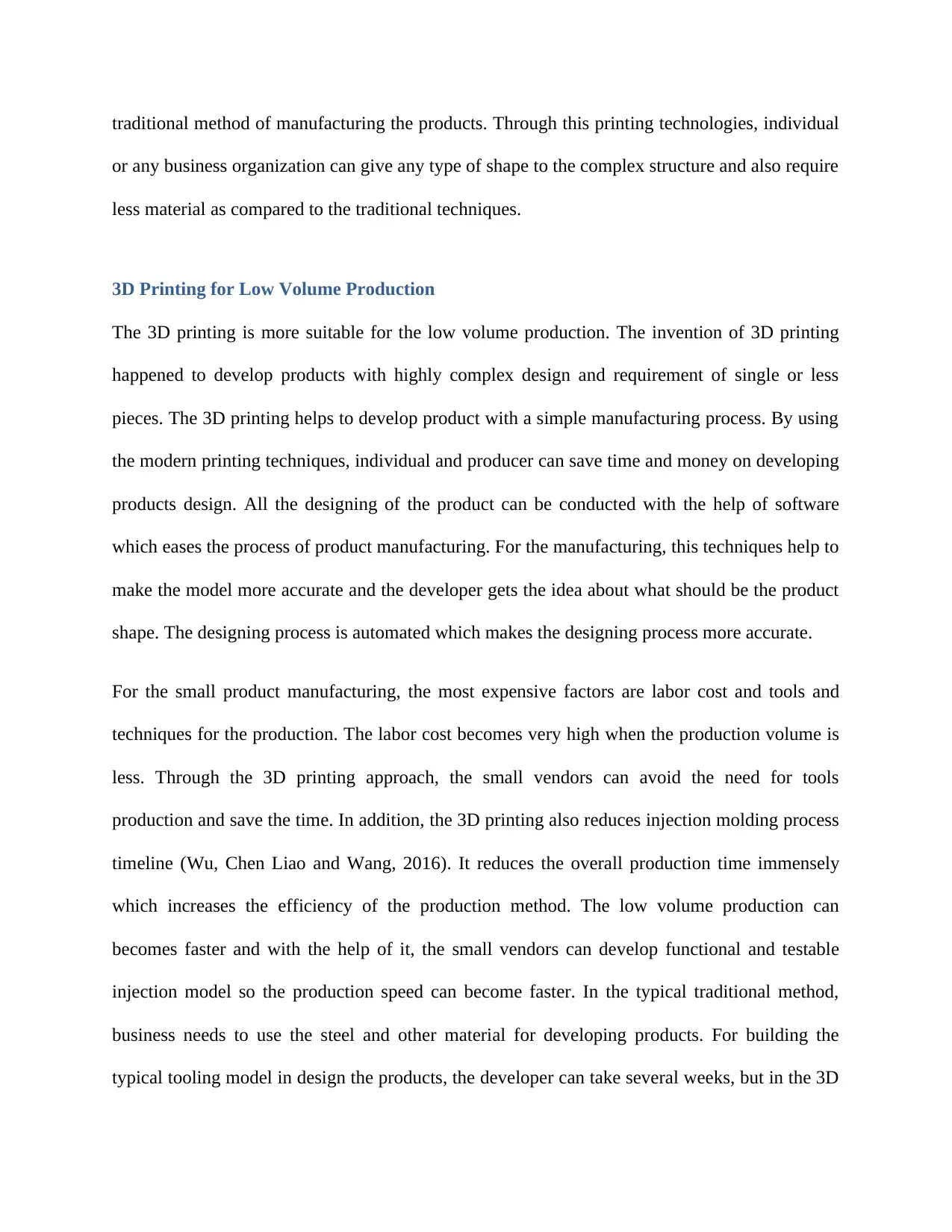
traditional method of manufacturing the products. Through this printing technologies, individual
or any business organization can give any type of shape to the complex structure and also require
less material as compared to the traditional techniques.
3D Printing for Low Volume Production
The 3D printing is more suitable for the low volume production. The invention of 3D printing
happened to develop products with highly complex design and requirement of single or less
pieces. The 3D printing helps to develop product with a simple manufacturing process. By using
the modern printing techniques, individual and producer can save time and money on developing
products design. All the designing of the product can be conducted with the help of software
which eases the process of product manufacturing. For the manufacturing, this techniques help to
make the model more accurate and the developer gets the idea about what should be the product
shape. The designing process is automated which makes the designing process more accurate.
For the small product manufacturing, the most expensive factors are labor cost and tools and
techniques for the production. The labor cost becomes very high when the production volume is
less. Through the 3D printing approach, the small vendors can avoid the need for tools
production and save the time. In addition, the 3D printing also reduces injection molding process
timeline (Wu, Chen Liao and Wang, 2016). It reduces the overall production time immensely
which increases the efficiency of the production method. The low volume production can
becomes faster and with the help of it, the small vendors can develop functional and testable
injection model so the production speed can become faster. In the typical traditional method,
business needs to use the steel and other material for developing products. For building the
typical tooling model in design the products, the developer can take several weeks, but in the 3D
or any business organization can give any type of shape to the complex structure and also require
less material as compared to the traditional techniques.
3D Printing for Low Volume Production
The 3D printing is more suitable for the low volume production. The invention of 3D printing
happened to develop products with highly complex design and requirement of single or less
pieces. The 3D printing helps to develop product with a simple manufacturing process. By using
the modern printing techniques, individual and producer can save time and money on developing
products design. All the designing of the product can be conducted with the help of software
which eases the process of product manufacturing. For the manufacturing, this techniques help to
make the model more accurate and the developer gets the idea about what should be the product
shape. The designing process is automated which makes the designing process more accurate.
For the small product manufacturing, the most expensive factors are labor cost and tools and
techniques for the production. The labor cost becomes very high when the production volume is
less. Through the 3D printing approach, the small vendors can avoid the need for tools
production and save the time. In addition, the 3D printing also reduces injection molding process
timeline (Wu, Chen Liao and Wang, 2016). It reduces the overall production time immensely
which increases the efficiency of the production method. The low volume production can
becomes faster and with the help of it, the small vendors can develop functional and testable
injection model so the production speed can become faster. In the typical traditional method,
business needs to use the steel and other material for developing products. For building the
typical tooling model in design the products, the developer can take several weeks, but in the 3D
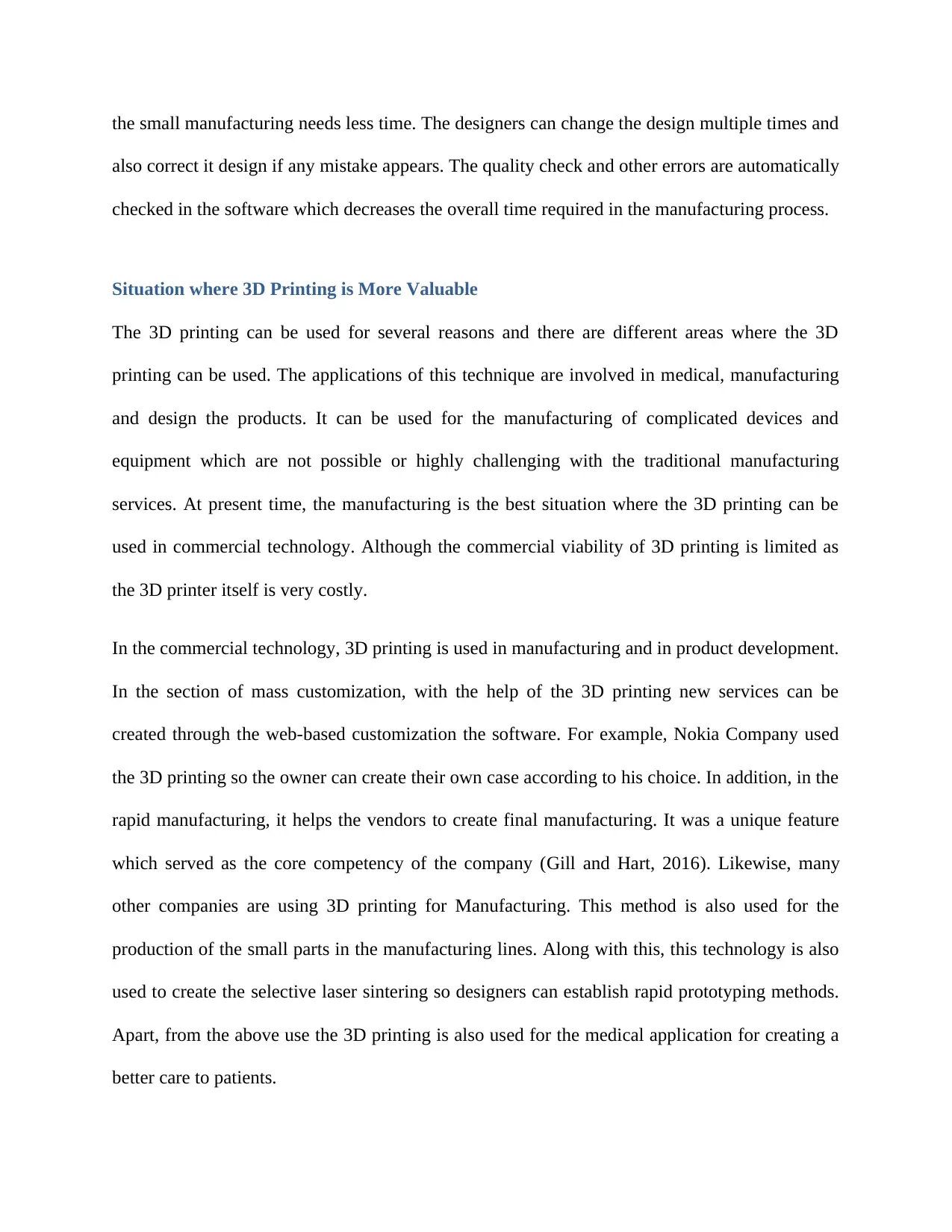
the small manufacturing needs less time. The designers can change the design multiple times and
also correct it design if any mistake appears. The quality check and other errors are automatically
checked in the software which decreases the overall time required in the manufacturing process.
Situation where 3D Printing is More Valuable
The 3D printing can be used for several reasons and there are different areas where the 3D
printing can be used. The applications of this technique are involved in medical, manufacturing
and design the products. It can be used for the manufacturing of complicated devices and
equipment which are not possible or highly challenging with the traditional manufacturing
services. At present time, the manufacturing is the best situation where the 3D printing can be
used in commercial technology. Although the commercial viability of 3D printing is limited as
the 3D printer itself is very costly.
In the commercial technology, 3D printing is used in manufacturing and in product development.
In the section of mass customization, with the help of the 3D printing new services can be
created through the web-based customization the software. For example, Nokia Company used
the 3D printing so the owner can create their own case according to his choice. In addition, in the
rapid manufacturing, it helps the vendors to create final manufacturing. It was a unique feature
which served as the core competency of the company (Gill and Hart, 2016). Likewise, many
other companies are using 3D printing for Manufacturing. This method is also used for the
production of the small parts in the manufacturing lines. Along with this, this technology is also
used to create the selective laser sintering so designers can establish rapid prototyping methods.
Apart, from the above use the 3D printing is also used for the medical application for creating a
better care to patients.
also correct it design if any mistake appears. The quality check and other errors are automatically
checked in the software which decreases the overall time required in the manufacturing process.
Situation where 3D Printing is More Valuable
The 3D printing can be used for several reasons and there are different areas where the 3D
printing can be used. The applications of this technique are involved in medical, manufacturing
and design the products. It can be used for the manufacturing of complicated devices and
equipment which are not possible or highly challenging with the traditional manufacturing
services. At present time, the manufacturing is the best situation where the 3D printing can be
used in commercial technology. Although the commercial viability of 3D printing is limited as
the 3D printer itself is very costly.
In the commercial technology, 3D printing is used in manufacturing and in product development.
In the section of mass customization, with the help of the 3D printing new services can be
created through the web-based customization the software. For example, Nokia Company used
the 3D printing so the owner can create their own case according to his choice. In addition, in the
rapid manufacturing, it helps the vendors to create final manufacturing. It was a unique feature
which served as the core competency of the company (Gill and Hart, 2016). Likewise, many
other companies are using 3D printing for Manufacturing. This method is also used for the
production of the small parts in the manufacturing lines. Along with this, this technology is also
used to create the selective laser sintering so designers can establish rapid prototyping methods.
Apart, from the above use the 3D printing is also used for the medical application for creating a
better care to patients.
⊘ This is a preview!⊘
Do you want full access?
Subscribe today to unlock all pages.

Trusted by 1+ million students worldwide
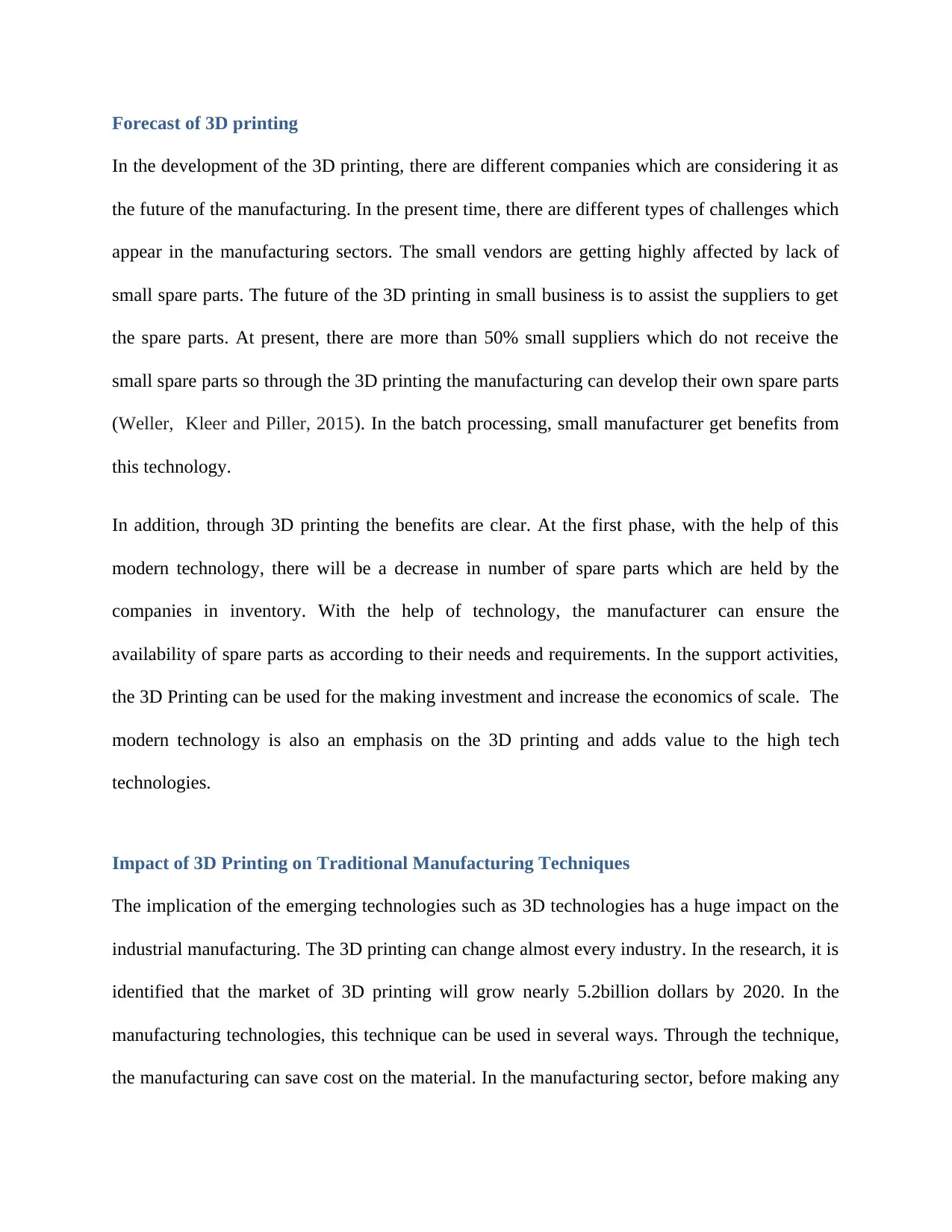
Forecast of 3D printing
In the development of the 3D printing, there are different companies which are considering it as
the future of the manufacturing. In the present time, there are different types of challenges which
appear in the manufacturing sectors. The small vendors are getting highly affected by lack of
small spare parts. The future of the 3D printing in small business is to assist the suppliers to get
the spare parts. At present, there are more than 50% small suppliers which do not receive the
small spare parts so through the 3D printing the manufacturing can develop their own spare parts
(Weller, Kleer and Piller, 2015). In the batch processing, small manufacturer get benefits from
this technology.
In addition, through 3D printing the benefits are clear. At the first phase, with the help of this
modern technology, there will be a decrease in number of spare parts which are held by the
companies in inventory. With the help of technology, the manufacturer can ensure the
availability of spare parts as according to their needs and requirements. In the support activities,
the 3D Printing can be used for the making investment and increase the economics of scale. The
modern technology is also an emphasis on the 3D printing and adds value to the high tech
technologies.
Impact of 3D Printing on Traditional Manufacturing Techniques
The implication of the emerging technologies such as 3D technologies has a huge impact on the
industrial manufacturing. The 3D printing can change almost every industry. In the research, it is
identified that the market of 3D printing will grow nearly 5.2billion dollars by 2020. In the
manufacturing technologies, this technique can be used in several ways. Through the technique,
the manufacturing can save cost on the material. In the manufacturing sector, before making any
In the development of the 3D printing, there are different companies which are considering it as
the future of the manufacturing. In the present time, there are different types of challenges which
appear in the manufacturing sectors. The small vendors are getting highly affected by lack of
small spare parts. The future of the 3D printing in small business is to assist the suppliers to get
the spare parts. At present, there are more than 50% small suppliers which do not receive the
small spare parts so through the 3D printing the manufacturing can develop their own spare parts
(Weller, Kleer and Piller, 2015). In the batch processing, small manufacturer get benefits from
this technology.
In addition, through 3D printing the benefits are clear. At the first phase, with the help of this
modern technology, there will be a decrease in number of spare parts which are held by the
companies in inventory. With the help of technology, the manufacturer can ensure the
availability of spare parts as according to their needs and requirements. In the support activities,
the 3D Printing can be used for the making investment and increase the economics of scale. The
modern technology is also an emphasis on the 3D printing and adds value to the high tech
technologies.
Impact of 3D Printing on Traditional Manufacturing Techniques
The implication of the emerging technologies such as 3D technologies has a huge impact on the
industrial manufacturing. The 3D printing can change almost every industry. In the research, it is
identified that the market of 3D printing will grow nearly 5.2billion dollars by 2020. In the
manufacturing technologies, this technique can be used in several ways. Through the technique,
the manufacturing can save cost on the material. In the manufacturing sector, before making any
Paraphrase This Document
Need a fresh take? Get an instant paraphrase of this document with our AI Paraphraser
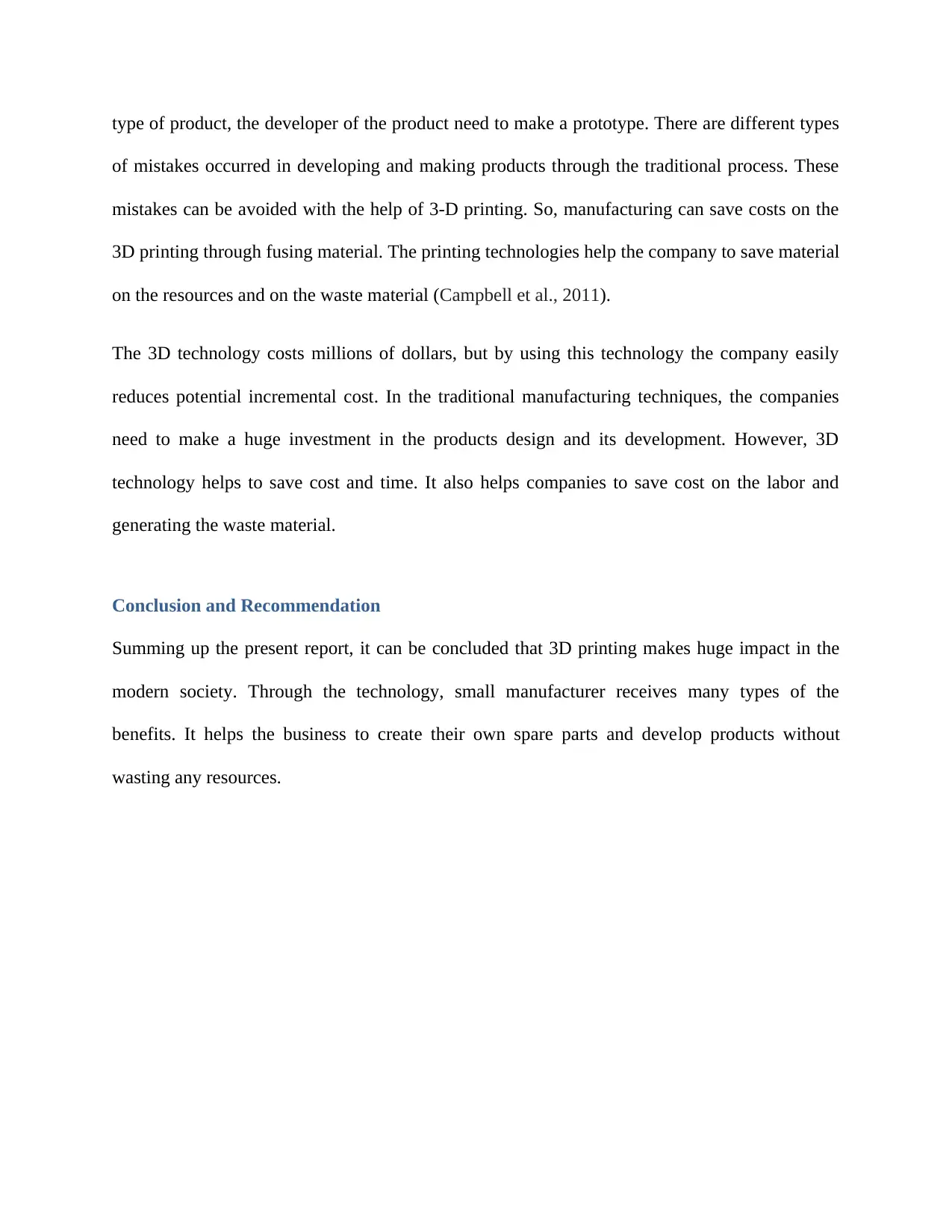
type of product, the developer of the product need to make a prototype. There are different types
of mistakes occurred in developing and making products through the traditional process. These
mistakes can be avoided with the help of 3-D printing. So, manufacturing can save costs on the
3D printing through fusing material. The printing technologies help the company to save material
on the resources and on the waste material (Campbell et al., 2011).
The 3D technology costs millions of dollars, but by using this technology the company easily
reduces potential incremental cost. In the traditional manufacturing techniques, the companies
need to make a huge investment in the products design and its development. However, 3D
technology helps to save cost and time. It also helps companies to save cost on the labor and
generating the waste material.
Conclusion and Recommendation
Summing up the present report, it can be concluded that 3D printing makes huge impact in the
modern society. Through the technology, small manufacturer receives many types of the
benefits. It helps the business to create their own spare parts and develop products without
wasting any resources.
of mistakes occurred in developing and making products through the traditional process. These
mistakes can be avoided with the help of 3-D printing. So, manufacturing can save costs on the
3D printing through fusing material. The printing technologies help the company to save material
on the resources and on the waste material (Campbell et al., 2011).
The 3D technology costs millions of dollars, but by using this technology the company easily
reduces potential incremental cost. In the traditional manufacturing techniques, the companies
need to make a huge investment in the products design and its development. However, 3D
technology helps to save cost and time. It also helps companies to save cost on the labor and
generating the waste material.
Conclusion and Recommendation
Summing up the present report, it can be concluded that 3D printing makes huge impact in the
modern society. Through the technology, small manufacturer receives many types of the
benefits. It helps the business to create their own spare parts and develop products without
wasting any resources.
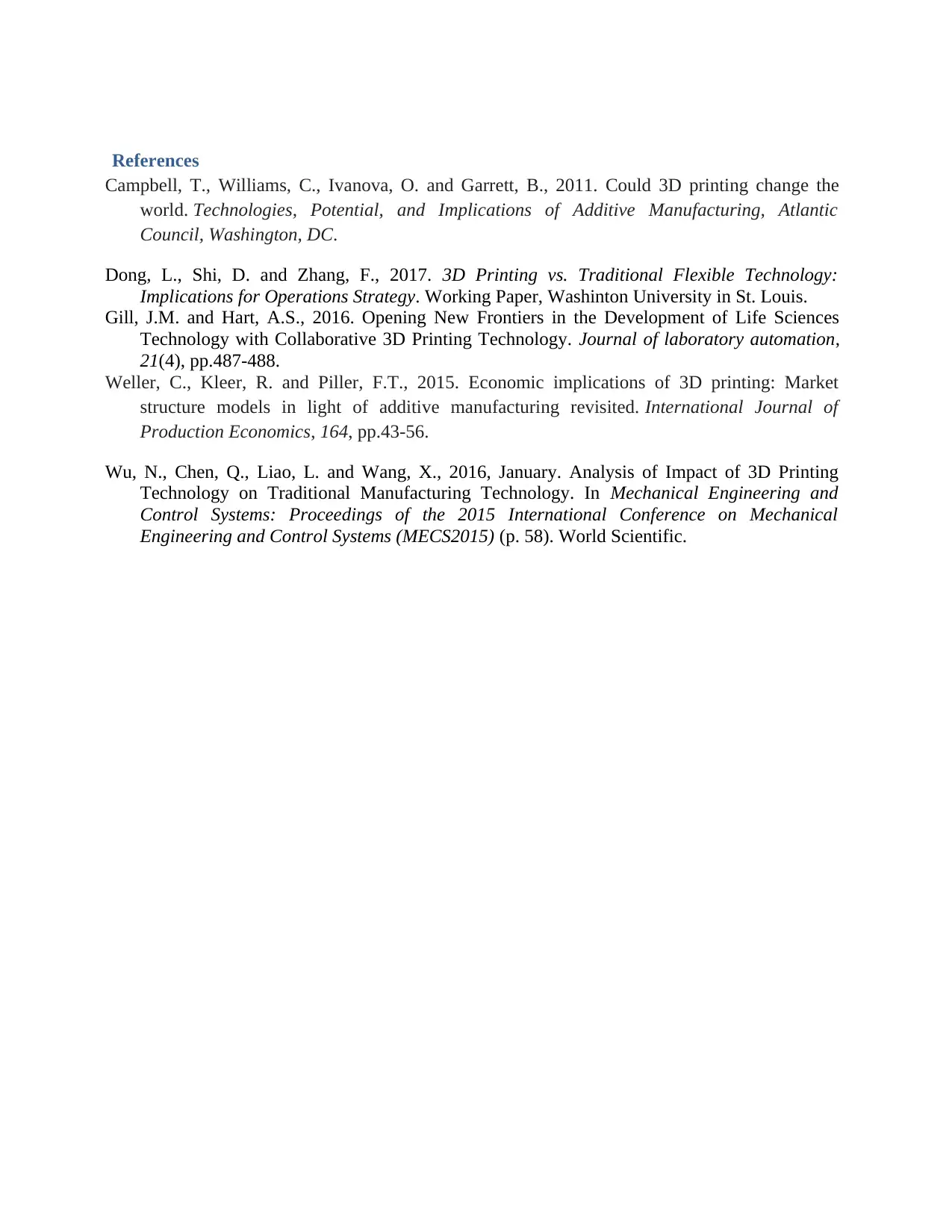
References
Campbell, T., Williams, C., Ivanova, O. and Garrett, B., 2011. Could 3D printing change the
world. Technologies, Potential, and Implications of Additive Manufacturing, Atlantic
Council, Washington, DC.
Dong, L., Shi, D. and Zhang, F., 2017. 3D Printing vs. Traditional Flexible Technology:
Implications for Operations Strategy. Working Paper, Washinton University in St. Louis.
Gill, J.M. and Hart, A.S., 2016. Opening New Frontiers in the Development of Life Sciences
Technology with Collaborative 3D Printing Technology. Journal of laboratory automation,
21(4), pp.487-488.
Weller, C., Kleer, R. and Piller, F.T., 2015. Economic implications of 3D printing: Market
structure models in light of additive manufacturing revisited. International Journal of
Production Economics, 164, pp.43-56.
Wu, N., Chen, Q., Liao, L. and Wang, X., 2016, January. Analysis of Impact of 3D Printing
Technology on Traditional Manufacturing Technology. In Mechanical Engineering and
Control Systems: Proceedings of the 2015 International Conference on Mechanical
Engineering and Control Systems (MECS2015) (p. 58). World Scientific.
Campbell, T., Williams, C., Ivanova, O. and Garrett, B., 2011. Could 3D printing change the
world. Technologies, Potential, and Implications of Additive Manufacturing, Atlantic
Council, Washington, DC.
Dong, L., Shi, D. and Zhang, F., 2017. 3D Printing vs. Traditional Flexible Technology:
Implications for Operations Strategy. Working Paper, Washinton University in St. Louis.
Gill, J.M. and Hart, A.S., 2016. Opening New Frontiers in the Development of Life Sciences
Technology with Collaborative 3D Printing Technology. Journal of laboratory automation,
21(4), pp.487-488.
Weller, C., Kleer, R. and Piller, F.T., 2015. Economic implications of 3D printing: Market
structure models in light of additive manufacturing revisited. International Journal of
Production Economics, 164, pp.43-56.
Wu, N., Chen, Q., Liao, L. and Wang, X., 2016, January. Analysis of Impact of 3D Printing
Technology on Traditional Manufacturing Technology. In Mechanical Engineering and
Control Systems: Proceedings of the 2015 International Conference on Mechanical
Engineering and Control Systems (MECS2015) (p. 58). World Scientific.
⊘ This is a preview!⊘
Do you want full access?
Subscribe today to unlock all pages.

Trusted by 1+ million students worldwide
1 out of 9
Related Documents
Your All-in-One AI-Powered Toolkit for Academic Success.
+13062052269
info@desklib.com
Available 24*7 on WhatsApp / Email
![[object Object]](/_next/static/media/star-bottom.7253800d.svg)
Unlock your academic potential
Copyright © 2020–2025 A2Z Services. All Rights Reserved. Developed and managed by ZUCOL.





